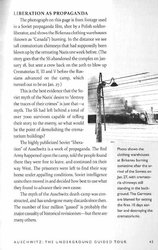Auschwitz, Destruction of Crematories
Moderator: Moderator
Forum rules
Be sure to read the Rules/guidelines before you post!
Be sure to read the Rules/guidelines before you post!
Auschwitz, Destruction of Crematories
I am unable to find in the forum if that document was ever mentioned or commented in the discussion about the alleged destruction of the crematories by the SS before the evacuation of Auschwitz.
As shown in p. 45 of the book of Carolyn Yeager "Auschwitz: The Underground Guided Tour" (2010), it is supposed to be a picture taken from a Soviet propaganda film. Of course, if some footage taken after the liberation of the camp could show chimneys of crematories, that would constitute a hard evidence that SS hadn't "completely erased all traces of their crimes" before they abandoned the place. As consequence and as alleged by Carolyn Yeager, the complete destruction of crematories should be actually attributed to the Soviets.
However, in order to verify the context of that picture, I would like to have access to the film made by the Russians in its genuine presentation but I don't know how to make it. I guess it may be the film in which the plans of crematories can be visible as well as the remaining children of the camp. I suppose it could be available on Youtube for whom is familiar with Russian or Polish languages. Could anyone check it?
Some footages taken out from the genuine Soviet film appear in that documentary
The Liberation of Auschwitz HISTORY DOCUMENTARY
http://www.youtube.com/watch?v=ii7gVIOyR_M
As shown in p. 45 of the book of Carolyn Yeager "Auschwitz: The Underground Guided Tour" (2010), it is supposed to be a picture taken from a Soviet propaganda film. Of course, if some footage taken after the liberation of the camp could show chimneys of crematories, that would constitute a hard evidence that SS hadn't "completely erased all traces of their crimes" before they abandoned the place. As consequence and as alleged by Carolyn Yeager, the complete destruction of crematories should be actually attributed to the Soviets.
However, in order to verify the context of that picture, I would like to have access to the film made by the Russians in its genuine presentation but I don't know how to make it. I guess it may be the film in which the plans of crematories can be visible as well as the remaining children of the camp. I suppose it could be available on Youtube for whom is familiar with Russian or Polish languages. Could anyone check it?
Some footages taken out from the genuine Soviet film appear in that documentary
The Liberation of Auschwitz HISTORY DOCUMENTARY
http://www.youtube.com/watch?v=ii7gVIOyR_M
Re: Auschwitz, Destruction of Crematories
I commented along the same lines in regards to the alleged escape from Sobibor and the other Reinhardt camps for that matter.
These alleged events are repeated often enough that they become accepted as fact, revisionists for the most part don't even bother to challenge these stories.
Why would the German's destroy the crematoriums at Birkenau?
What evidence would they have been leaving behind if those building were left intact?
Does Carolyn Yeager mention why according to the Russians those warehouses are on fire, did they claim that the Germans set them on fire and they were still burning when they got there?
These alleged events are repeated often enough that they become accepted as fact, revisionists for the most part don't even bother to challenge these stories.
Why would the German's destroy the crematoriums at Birkenau?
What evidence would they have been leaving behind if those building were left intact?
Does Carolyn Yeager mention why according to the Russians those warehouses are on fire, did they claim that the Germans set them on fire and they were still burning when they got there?
Re: Auschwitz, Destruction of Crematories
Zulu wrote:However, in order to verify the context of that picture, I would like to have access to the film made by the Russians in its genuine presentation but I don't know how to make it. I guess it may be the film in which the plans of crematories can be visible as well as the remaining children of the camp. I suppose it could be available on Youtube for whom is familiar with Russian or Polish languages. Could anyone check it?
Some footages taken out from the genuine Soviet film appear in that documentary
The Liberation of Auschwitz HISTORY DOCUMENTARY
http://www.youtube.com/watch?v=ii7gVIOyR_M
As the film you've posted shows, the Soviets apparently felt it was unuseful to film Krema II and III, the epicenter of today's Holocaust narrative, for posterity...
No Footage of Krema II and III in the Soviet 1945 documentary “The Liberation of Auschwitz”
Immediately after the liberation of Auschwitz, the Soviets sent a film crew in to make an extensive newsreel documentary. This documentary was later shown at the Nuremberg Trials. In the last few years it has been released on DVD (and can be downloaded in various places on the Internet by googling the terms “The Liberation of Auschwitz” avi). Curiously, although there was extensive coverage of clearing away the ruins of Krema V, it appears on first viewing to contain no images of Krema II and III (allegedly the main gassing facilities) or Krema IV at all.
The thought occurs that given Krema II and III were supposedly the epicenter of the extermination program, perhaps the reason they did not appear on film is because they were not ready yet to be shown to the public.
http://littlegreyrabbit.wordpress.com/2 ... auschwitz/
Not surprising as the Soviets first claimed the gas chambers were located in the Eastern part of the camp while Birkenau and its Kremas were in the Western part of it.
February 2, 1945 Pravda, organ of the Central Committee of the Communist Party of the Soviet Union:
THE FACTORY OF DEATH AT AUSCHWITZ
[...]
Last year, when the Red Army revealed to the world the terrible and abominable secrets of Majdanek, the Germans in Auschwitz began to wipe out the traces of their crimes. They leveled the mounds of the so-called "old" [3] graves in the Eastern [4] part of the camp, tore up and destroyed the traces of the electric conveyor belt, on which hundreds of people were simultaneously electrocuted, their bodies falling onto the slow moving conveyor belt which carried them to the top of the blast furnace [5] where they fell in, were completely burned, their bones converted to meal in the rolling mills, and then sent to the surrounding fields. In retreat were taken the special transportable apparatuses for killing children. The stationary gas chambers in the eastern part of the camp were restructured, even little turrets and other architectural embellishments were added so that they would look like innocent garages.
http://www.fpp.co.uk/Auschwitz/docs/Pravda020245.html
"[Austen Chamberlain] has done western civilization a great service by refuting at least one of the slanders against the Germans
because a civilization which leaves war lies unchallenged in an atmosphere of hatred and does not produce courage in its leaders to refute them
is doomed. "
Deutsche Allgemeine Zeitung, on the public admission by Britain's Foreign Secretary that the WWI corpse-factory story was false, December 4, 1925
because a civilization which leaves war lies unchallenged in an atmosphere of hatred and does not produce courage in its leaders to refute them
is doomed. "
Deutsche Allgemeine Zeitung, on the public admission by Britain's Foreign Secretary that the WWI corpse-factory story was false, December 4, 1925
Re: Auschwitz, Destruction of Crematories
cold beer wrote:
Why would the German's destroy the crematoriums at Birkenau?
What evidence would they have been leaving behind if those building were left intact?
You have to see the Soviet anti-German propaganda after the liberation of Majdanek in 1944 if you want to understand why they had good reasons to destroy their Auschwitz crematoria before leaving.
See here: Australian Inmate at Terezin Says No Gas Chambers
Last edited by hermod on Wed Nov 13, 2013 7:38 pm, edited 1 time in total.
"[Austen Chamberlain] has done western civilization a great service by refuting at least one of the slanders against the Germans
because a civilization which leaves war lies unchallenged in an atmosphere of hatred and does not produce courage in its leaders to refute them
is doomed. "
Deutsche Allgemeine Zeitung, on the public admission by Britain's Foreign Secretary that the WWI corpse-factory story was false, December 4, 1925
because a civilization which leaves war lies unchallenged in an atmosphere of hatred and does not produce courage in its leaders to refute them
is doomed. "
Deutsche Allgemeine Zeitung, on the public admission by Britain's Foreign Secretary that the WWI corpse-factory story was false, December 4, 1925
Re: Auschwitz, Destruction of Crematories
hermod wrote:You have to see the Soviet anti-German propaganda after the liberation of Majdanek in 1944 if you want to understand why they had good reasons to destroy their Auschwitz crematoria before leaving.
See here: Australian Inmate at Terezin Says No Gas Chambers
I read through this material, it's a theory, but one that I have trouble accepting.
Everyone knows that the camp will have cremation ovens and when you destroy the buildings it is as if you are attempting to cover up something, which would only bolster enemy propaganda.
- Kladderadatsch
- Valued contributor

- Posts: 255
- Joined: Tue Jan 03, 2012 11:08 am
Re: Auschwitz, Destruction of Crematories
I very much doubt that the chimneys in the background belong to a Krema building. To see why, it would help to look at a better (uncropped) version of the picture:
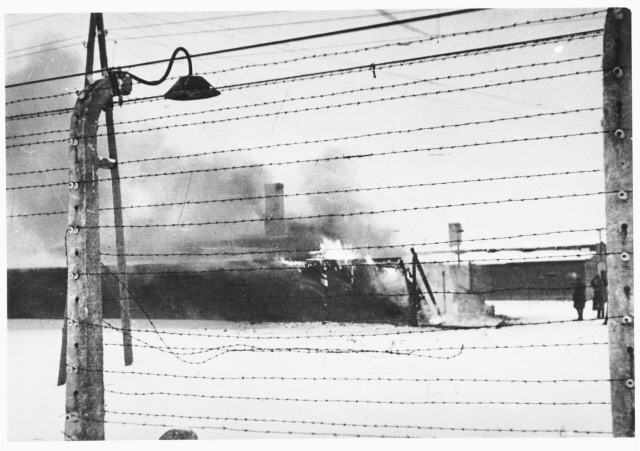
Source: http://collections.ushmm.org/search/catalog/pa1144233 (This page has extra details about the provenance of the picture, btw.)
In the uncropped photo, it's clear that the barracks in the foreground are viewed end-on, as can be seen in particular at the right-hand edge of the frame. But that would mean, for the picture to make sense, that the cameraman would have to be standing behind at least one row of barracks, and shooting along their length towards the chimneys. Using Google Maps, then, we can locate the closest possible point for the shot:

From there to the chimneys of Krema 4 would have been a little over 120 meters:
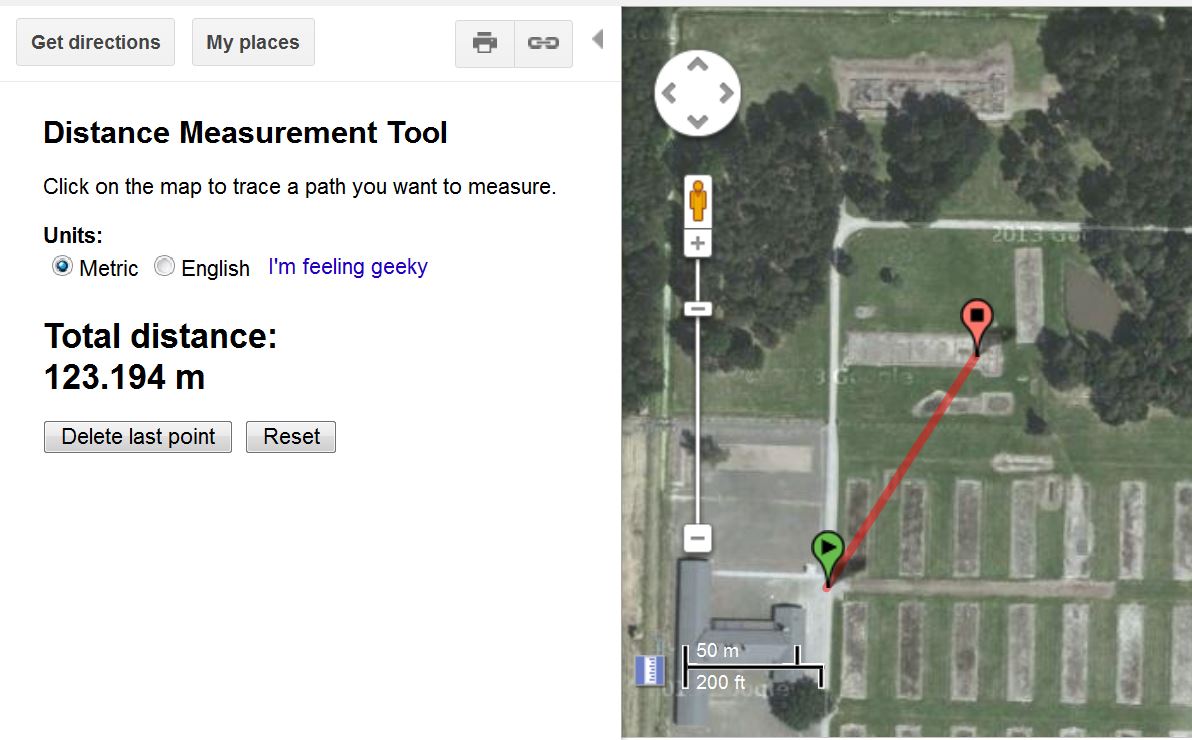
But as Carolyn's text implies in mentioning Kremas 2, 3 and 5--but not 4--as having been allegedly destroyed in January 1945, that wouldn't make sense since Krema 4 almost certainly had been demolished much earlier, in autumn of 1944. This is confirmed by the aerial photo of the camp from 21 December of that year:

Source: http://upload.wikimedia.org/wikipedia/c ... er1944.jpg (The picture is rotated 90 degrees. I've marked the likely camera location again with a green arrow.)
So if the chimneys couldn't belong to Krema 4, the next closest option would be Krema 5, but now that's nearly 230 meters away:

The K4-5 chimneys were pretty big structures at just shy of 17 m tall and nearly 1.6 m wide at the top (see Pressac, p. 405). With a clear line of sight, the K5 pair no doubt would have been visible . . . but would they have appeared as large as they do in the photo? Consider as well that the chimneys were themselves no more than about ten meters apart (see for example the plan reproduced in Pressac p. 399; the numbers are hard to read, but a reasonable estimate can be made just by using the size of the doors as a benchmark). I won't try to do the trigonometry here (that might be embarrasing, lol), but I think anyone can see, intuitively, that if those chimneys are 200+ meters away, they'd have to be more ten meters apart. (The same goes, in fact, even if they belonged to K4 at a 120 meters away.)
Turning around and switching sides to keep the fence on the right, the distances to K2 and K3 are even greater:
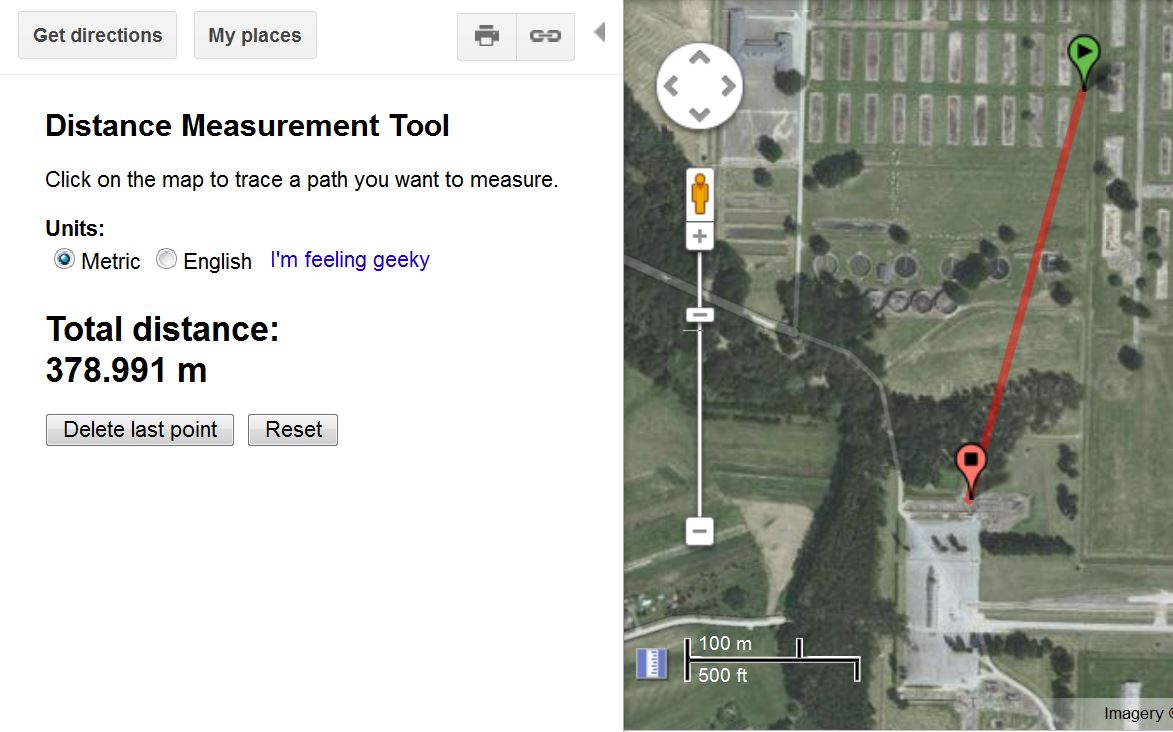
K3, the nearer of the two, is about 380 meters from the closest likely camera location, and of course K2 and 3 only had one chimney each. Finally, the angle would be wrong to catch even one of the chimneys (K3's) along with the Kanada barracks, let alone both.
In other words, the chimneys in the "Kanada burning" photo simply can't have belonged to an undestroyed Krema building. So what were they then? Probably just the heating-stove chimneys that were installed in all of the residential barracks at Birkenau and which still litter the site to this day:

Were such chimneys installed in the buildings of the Kanada area? I don't know. But it seems the most likely explanation . . . assuming the picture really does show Kanada.
I agree with Carolyn that there's a lot that's suspicious about the story of how the Germans allegedly snuck back into Birkenau to blow up the Krema buildings in order to "destroy all traces of their crimes" but I don't think this picture does much to disprove it. In a way, actually, I think that the earlier demolition of the K4 building--and thus its absence from the picture--may be the best clue to why the Kremas were taken apart in the first place. The crematory ovens in K4 failed shortly after installation (see Pressac p. 379ff for details) and the site never became operational, so the Germans simply dismantled it in order to use the materials elsewhere.
In other words, if they were concerned about destroying buildings to eliminate evidence, the Germans could (playing along with the official storyline for a moment . . . ) have left K4 standing and focused on dismantling the other Kremas instead. After all, compared to the other buildings, K4 should have been almost completely free of dangerous "criminal traces." Instead, they did what sensible site managers naturally would do: they dismantled structures in order of least-used as they prepared to pull out, so that they could salvage materials and equipment for elsewhere and deny their use to the enemy, all the while maintaining site-functionality for as along as possible--something which would, at all times, have included the necessary presence of the crematories in order to maintain hygiene in a camp threatened with epidemic disease. There's no mystery to it, and no evidence of "consciousness of guilt."
I too suspect that the "blowing up of the gas chambers" is probably a myth, with the real vandals being the Soviets, but even if the Germans had resorted to explosives, it would only have been to complete a job started months before for reasons having nothing to do with deception. Either way, though, we will have to rely on other evidence than Makarewicz's picture.

Source: http://collections.ushmm.org/search/catalog/pa1144233 (This page has extra details about the provenance of the picture, btw.)
In the uncropped photo, it's clear that the barracks in the foreground are viewed end-on, as can be seen in particular at the right-hand edge of the frame. But that would mean, for the picture to make sense, that the cameraman would have to be standing behind at least one row of barracks, and shooting along their length towards the chimneys. Using Google Maps, then, we can locate the closest possible point for the shot:

From there to the chimneys of Krema 4 would have been a little over 120 meters:

But as Carolyn's text implies in mentioning Kremas 2, 3 and 5--but not 4--as having been allegedly destroyed in January 1945, that wouldn't make sense since Krema 4 almost certainly had been demolished much earlier, in autumn of 1944. This is confirmed by the aerial photo of the camp from 21 December of that year:

Source: http://upload.wikimedia.org/wikipedia/c ... er1944.jpg (The picture is rotated 90 degrees. I've marked the likely camera location again with a green arrow.)
So if the chimneys couldn't belong to Krema 4, the next closest option would be Krema 5, but now that's nearly 230 meters away:

The K4-5 chimneys were pretty big structures at just shy of 17 m tall and nearly 1.6 m wide at the top (see Pressac, p. 405). With a clear line of sight, the K5 pair no doubt would have been visible . . . but would they have appeared as large as they do in the photo? Consider as well that the chimneys were themselves no more than about ten meters apart (see for example the plan reproduced in Pressac p. 399; the numbers are hard to read, but a reasonable estimate can be made just by using the size of the doors as a benchmark). I won't try to do the trigonometry here (that might be embarrasing, lol), but I think anyone can see, intuitively, that if those chimneys are 200+ meters away, they'd have to be more ten meters apart. (The same goes, in fact, even if they belonged to K4 at a 120 meters away.)
Turning around and switching sides to keep the fence on the right, the distances to K2 and K3 are even greater:

K3, the nearer of the two, is about 380 meters from the closest likely camera location, and of course K2 and 3 only had one chimney each. Finally, the angle would be wrong to catch even one of the chimneys (K3's) along with the Kanada barracks, let alone both.
In other words, the chimneys in the "Kanada burning" photo simply can't have belonged to an undestroyed Krema building. So what were they then? Probably just the heating-stove chimneys that were installed in all of the residential barracks at Birkenau and which still litter the site to this day:

Were such chimneys installed in the buildings of the Kanada area? I don't know. But it seems the most likely explanation . . . assuming the picture really does show Kanada.
I agree with Carolyn that there's a lot that's suspicious about the story of how the Germans allegedly snuck back into Birkenau to blow up the Krema buildings in order to "destroy all traces of their crimes" but I don't think this picture does much to disprove it. In a way, actually, I think that the earlier demolition of the K4 building--and thus its absence from the picture--may be the best clue to why the Kremas were taken apart in the first place. The crematory ovens in K4 failed shortly after installation (see Pressac p. 379ff for details) and the site never became operational, so the Germans simply dismantled it in order to use the materials elsewhere.
In other words, if they were concerned about destroying buildings to eliminate evidence, the Germans could (playing along with the official storyline for a moment . . . ) have left K4 standing and focused on dismantling the other Kremas instead. After all, compared to the other buildings, K4 should have been almost completely free of dangerous "criminal traces." Instead, they did what sensible site managers naturally would do: they dismantled structures in order of least-used as they prepared to pull out, so that they could salvage materials and equipment for elsewhere and deny their use to the enemy, all the while maintaining site-functionality for as along as possible--something which would, at all times, have included the necessary presence of the crematories in order to maintain hygiene in a camp threatened with epidemic disease. There's no mystery to it, and no evidence of "consciousness of guilt."
I too suspect that the "blowing up of the gas chambers" is probably a myth, with the real vandals being the Soviets, but even if the Germans had resorted to explosives, it would only have been to complete a job started months before for reasons having nothing to do with deception. Either way, though, we will have to rely on other evidence than Makarewicz's picture.
Der grosse Kladderadatsch war da.
-- D. Eckart Der Bolschewismus von Moses bis Lenin, "Er"
-- D. Eckart Der Bolschewismus von Moses bis Lenin, "Er"
Re: Auschwitz, Destruction of Crematories
cold beer wrote:hermod wrote:You have to see the Soviet anti-German propaganda after the liberation of Majdanek in 1944 if you want to understand why they had good reasons to destroy their Auschwitz crematoria before leaving.
See here: Australian Inmate at Terezin Says No Gas Chambers
I read through this material, it's a theory, but one that I have trouble accepting.
Everyone knows that the camp will have cremation ovens and when you destroy the buildings it is as if you are attempting to cover up something, which would only bolster enemy propaganda.
Do you think such pictures (see below) didn't bolster enemy propaganda?
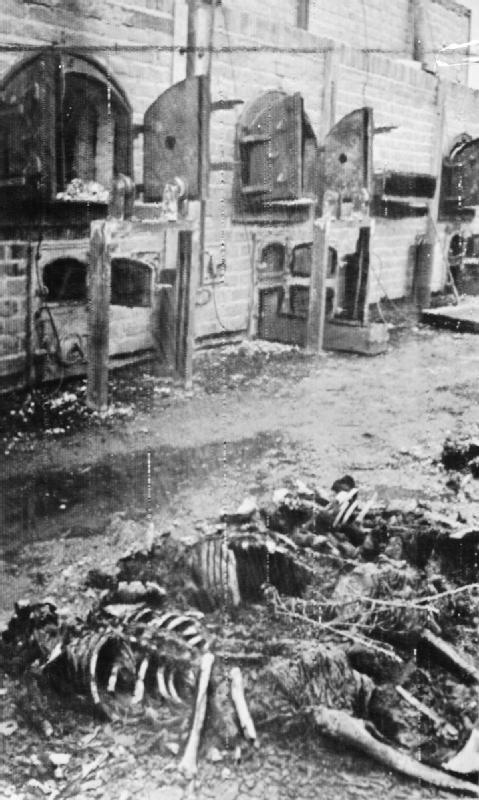
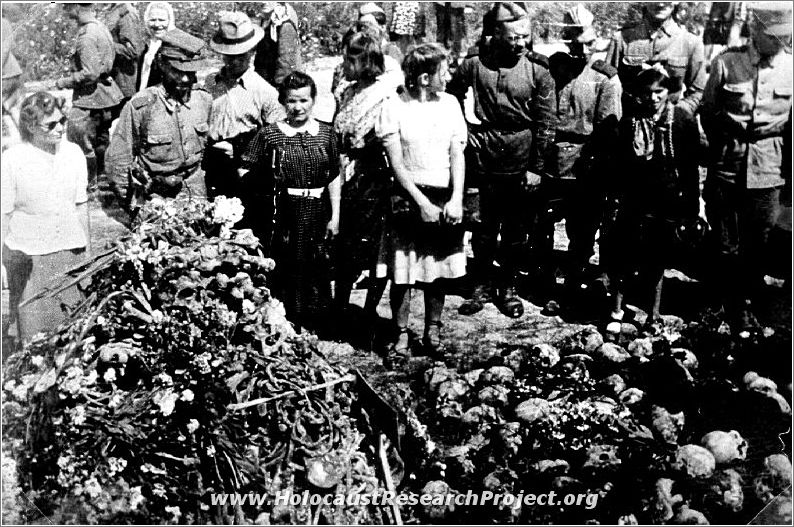
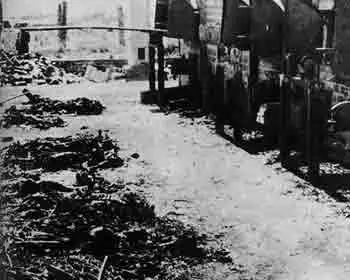

That was typically the anti-German propaganda spread in the second half of 1944, not only in the Soviet Union (American and British newspapers often used those pictures too in order to illustrate their articles on "the Evil Huns").
The propaganda circus using the 'atrocity' pictures taken at Majdanek was running at full speed in the Western world too in late 1944...
Cremation was pretty rare in the Christian world at that time. Pictures of crematory ovens and partly-cremated bodies deeply impressed that time's Christian citizens living in the Allied countries. That's why the American propagandists also focused their atrocity propaganda on pictures of crematory ovens when the U.S. troops entered German concentration camps in spring 1945. Cremation was so shocking to that's time Christians that Allied propagandists mixed the gas chamber hoax with the crematory oven pictures and the ridiculous "gas ovens" myth survived for a very long time after the end of WW2.
As you can see, destroying crematories didn't necessarily mean you had something to hide, but it could mean (IMO it did) you had something you didn't want to show because it could very easily be misrepresented by your enemies and misinterpreted by their citizens. It's still often misinterpreted today, even if cremation is widely used in today's Christian countries: never debatted with a Holocaust believer telling you "And what about the ovens, stupid denier?" or something like that?
In fact, destroying the Birkenau crematories was first very efficient in propagandistic terms. From February 1945 to the end of WW2, the recently-liberated "death factory" of Oswiecim (Auschwitz) wasn't used a lot by Allied propaganda and only a few articles (with no pictures) about murderous conveyor belts and gas chambers were published in Allied newspapers. Auschwitz was more or less a propagandistic failure for the Allies during the first months after the liberation of that camp because there was nothing very sensational to show. In terms of atrocity propaganda, Majdanek, Belsen, Dachau and Buchenwald were first way more sucessfull because there were many sensational pictures (some staged ones like "the horror table" of Buchenwald) to show. If you had asked questions about Sobibor, Treblinka or Auschwitz to an American Citizen in the 1950's, he would probably have asked you what you were talking about. But if you had said Dachau, Buchenwald or Belsen to him, he would have had tons of things to tell you.
"[Austen Chamberlain] has done western civilization a great service by refuting at least one of the slanders against the Germans
because a civilization which leaves war lies unchallenged in an atmosphere of hatred and does not produce courage in its leaders to refute them
is doomed. "
Deutsche Allgemeine Zeitung, on the public admission by Britain's Foreign Secretary that the WWI corpse-factory story was false, December 4, 1925
because a civilization which leaves war lies unchallenged in an atmosphere of hatred and does not produce courage in its leaders to refute them
is doomed. "
Deutsche Allgemeine Zeitung, on the public admission by Britain's Foreign Secretary that the WWI corpse-factory story was false, December 4, 1925
Re: Auschwitz, Destruction of Crematories
hermod wrote:Do you think such pictures (see below) didn't bolster enemy propaganda?
Oh no i never said that, images are a big part of the propaganda tool kit.
But the American public was already well aware of the use of cremation ovens in German concentration camps long before the Soviets entered Auschwitz.
The Germans, so they say, mistakenly or hurriedly left behind images of those very same ovens.
What bumblers, a big group of Stg Shultz's !
hermod wrote:Cremation was pretty rare in the Christian world at that time. Pictures of crematory ovens and partly-cremated bodies deeply impressed that time's Christian citizens living in the Allied countries. That's why the American propagandists also focused their atrocity propaganda on pictures of crematory ovens when the U.S. troops entered German concentration camps in spring 1945. Cremation was so shocking to that's time Christians that Allied propagandists mixed the gas chamber hoax with the crematory oven pictures and the ridiculous "gas ovens" myth survived for a very long time after the end of WW2.
The United States was more majority Christian during and in the years immediately following the war than it is now by a significant margin,
It's not the images of the ovens that invoke TODAY'S typical reaction it's the association to the narrative that's been engrained in the minds of the public over decades.
The majority of the comparatively larger Christian demographic that existed during the WW2 era dismissed this propaganda and saw it for what it was.
If this theory held any water we would have witnessed a public far more inclined to bite hook line and sinker, than what we see today
If you don't believe me, then take it right from the horse's trap in this article by Deborah Lipstadt, in which she describes how intractable the WW2 super majority of Christians were in their belief that all of this was nothing but more Bolshevik propaganda
http://fotos.fotoflexer.com/a2491554ec931c2753a02c15c27453fd.jpg
Last edited by cold beer on Thu Nov 14, 2013 12:24 pm, edited 1 time in total.
Re: Auschwitz, Destruction of Crematories
I appreciate you posting these pictures, because they have a direct tie-in with the article by this Lipstadt woman in which she's maintaining the outrageous claim, more than 30 years after the fact (I believe the article was written in 1978), that the 'allies' (the Soviets) discovered the remains of 1.7 million Jews at Majdanek.
The pictures don't match the story, the piles are far too small.
You also have to wonder how they determined that these bones were Jews.
The pictures don't match the story, the piles are far too small.
You also have to wonder how they determined that these bones were Jews.
Re: Auschwitz, Destruction of Crematories
Kladderadatsch
Taking a more careful look at what you've presented I agree that it's difficult to come up with a vantage point that would position the buildings in the foreground with the stacks in the background as shown
It seems logical that Krema 4&5 should be ruled out because they each had two stacks, and these stacks seem too far apart to belong to the same crematory building.
I don't believe that the stacks belong to the same type of buildings seen in the foreground, a roof line can be seen under the closer stack that is higher than the buildings in the foreground.
Taking a more careful look at what you've presented I agree that it's difficult to come up with a vantage point that would position the buildings in the foreground with the stacks in the background as shown
It seems logical that Krema 4&5 should be ruled out because they each had two stacks, and these stacks seem too far apart to belong to the same crematory building.
I don't believe that the stacks belong to the same type of buildings seen in the foreground, a roof line can be seen under the closer stack that is higher than the buildings in the foreground.
Last edited by cold beer on Fri Nov 15, 2013 8:05 am, edited 1 time in total.
Re: Auschwitz, Destruction of Crematories
cold beer wrote:The United States was more majority Christian during and in the years immediately following the war than it is now by a significant margin,
It's not the images of the ovens that invoke TODAY'S typical reaction it's the association to the narrative that's been engrained in the minds of the public over decades.
True. Today's typical reaction invokes the pictures of typhus emaciated corpses most of the time. More powerful than pictures of crematory ovens. Most people ignores, still today, what the official Holocaust narrative is supposed to be. That's why 'Holocaust survivors' still tell enormous absurdities like gas turned on or gas coming from shower heads and nearly nobody ever notice those absurdities, what would permit them to understand most of the "survivors' tales" are ridiculous stories full of holes, even in the tales recently invented and published.
I don't think most of people still believe in "the Holocaust" because the Auschwitz crematories were destroyed or any other technical detail of the Holocaust myth. I think most people believe in "the Holocaust" because of shocking pictures and tears of 'survivors' pushed in their brain by the ceaseless Zionist propaganda they live in.
The majority of the comparatively larger Christian demographic that existed during the WW2 era dismissed this propaganda and saw it for what it was.
If this theory held any water we would have witnessed a public far more inclined to bite hook line and sinker, than what we see today
If you don't believe me, then take it right from the horse's trap in this article by Deborah Lipstadt, in which she describes how intractable the WW2 super majority of Christians were in their belief that all of this was nothing but more Bolshevik propaganda
http://fotos.fotoflexer.com/a2491554ec931c2753a02c15c27453fd.jpg
I already knew about the general disbelief in the atrocity stories among the American population during WW2 (because most Americans hadn't forgotten the propaganda lies of WW1 - Lipstadt is right at least on that point). But what was the real impact of the atrocity pictures taken at Majdanek on the Americans? Did their disbelief significantly decrease at that time? Lipstadt remains vague about that. As a picture is worth a thousand words, I think their disbelief significantly decreased when the Majdanek atrocity pictures were published and was brought to almost nothing when the pictures of typhus corpses bulldozed in massgraves at Belsen were published a few months later. Claiming most people now believe in "the Holocaust" because the Birkenau crematories were destroyed is absurd. During decades people believed the Nazis had left gas chambers "in their original state" at Auschwitz I, Dachau, Majdanek, Mauthausen, Sachsenhausen and other places and they didn't stop believing in "the Holocaust" because of that. At that time the typical answer was "How can you deny the Nazi gas chambers? I've seen one at Auschwitz and one at Dachau with my own eyes.". I've never heard them say "How can you deny the Nazi gas chambers? The Nazis destroyed the gas chambers they had at Birkenau.". That kind of argument exists only among the specialists on the exterminationist side. Ordinary people ignore those things. They believe in what they've seen or think they've seen - pictures of gassed people (in fact pictures of people who died from the terrible epidemics raging at Belsen and other camps in the very end of WW2), 'real gas chambers' (in fact Allied postwar 'reconstructions' and mislabelled rooms), human skin lamp shades, shrunken heads (many people still believe in those ridiculous 'Nazi artifacts'), etc - not in what they haven't seen - the 'gas chambers' of Krema II, III, IV & V, the 'gas chambers' of the Reinhardt camps, the bodies alleged cremated and reduced to nothing during Sonderaktion 1005, etc.
Last edited by hermod on Fri Nov 15, 2013 9:16 am, edited 3 times in total.
"[Austen Chamberlain] has done western civilization a great service by refuting at least one of the slanders against the Germans
because a civilization which leaves war lies unchallenged in an atmosphere of hatred and does not produce courage in its leaders to refute them
is doomed. "
Deutsche Allgemeine Zeitung, on the public admission by Britain's Foreign Secretary that the WWI corpse-factory story was false, December 4, 1925
because a civilization which leaves war lies unchallenged in an atmosphere of hatred and does not produce courage in its leaders to refute them
is doomed. "
Deutsche Allgemeine Zeitung, on the public admission by Britain's Foreign Secretary that the WWI corpse-factory story was false, December 4, 1925
- TheBlackRabbitofInlé
- Valuable asset

- Posts: 834
- Joined: Mon Sep 26, 2011 10:38 am
Re: Auschwitz, Destruction of Crematories
Excellent analysis Kladderadatsch. And I'm glad to learn you're still with us!
The theory that this picture shows the chimneys of either Kremas IV and V, or II and III, is silly for several reasons, as you've detailed. In regard to your 'likely camera location' (and I understand that you were only playing devil advocate with that), there is today no fence between Canada II (Section BIIg) and the Central Sauna, instead the entire section has a perimeter fence. As the following images obtained from Google Earth confirm:


Almost two years ago—before I gave up trying to convince Carolyn Yeager and Furtherglory (who originated this theory) that these were not crematoria chimneys but the chimneys of the burning barracks—I said that IF these really are buildings in Canada II in this video still (and I don't believe they are), because of the angle of the burning buildings, and the the fence in the foreground, the video could only have been shot from Section BIIf:

But that's impossible due to the fact that the fence posts overhand the wrong way to the ones in the Soviet footage.


Even the fence posts at Auschwitz have undergone "museological reconstruction" over the years, but they couldn't have turned them around.

from Auschwitz-Oświęcim (Rotterdam, 2011) by Hans Citroen and Barbara Starzyńska.
As to whether the storage barracks of Canada II possessed stoves and chimneys, there doesn't appear to be any evidence of them judging by the images available on Google Earth (although there appear to be two stray fence posts in the middle of Canada II!?):

I believe the burning buildings in the Soviet footage are not warehouses in Canada II, but prisoner barracks elsewhere in the camp which the Soviets burnt simply to film. Locating where they were seems impossible just from the single video still, although there is a utility pole present in it, which is worth bearing in mind.
Like Zulu, I'd be interested to see the the original footage which might offer further clues as to the real location of the burning barracks.
The theory that this picture shows the chimneys of either Kremas IV and V, or II and III, is silly for several reasons, as you've detailed. In regard to your 'likely camera location' (and I understand that you were only playing devil advocate with that), there is today no fence between Canada II (Section BIIg) and the Central Sauna, instead the entire section has a perimeter fence. As the following images obtained from Google Earth confirm:
Almost two years ago—before I gave up trying to convince Carolyn Yeager and Furtherglory (who originated this theory) that these were not crematoria chimneys but the chimneys of the burning barracks—I said that IF these really are buildings in Canada II in this video still (and I don't believe they are), because of the angle of the burning buildings, and the the fence in the foreground, the video could only have been shot from Section BIIf:
But that's impossible due to the fact that the fence posts overhand the wrong way to the ones in the Soviet footage.

Even the fence posts at Auschwitz have undergone "museological reconstruction" over the years, but they couldn't have turned them around.
from Auschwitz-Oświęcim (Rotterdam, 2011) by Hans Citroen and Barbara Starzyńska.
As to whether the storage barracks of Canada II possessed stoves and chimneys, there doesn't appear to be any evidence of them judging by the images available on Google Earth (although there appear to be two stray fence posts in the middle of Canada II!?):
I believe the burning buildings in the Soviet footage are not warehouses in Canada II, but prisoner barracks elsewhere in the camp which the Soviets burnt simply to film. Locating where they were seems impossible just from the single video still, although there is a utility pole present in it, which is worth bearing in mind.
Like Zulu, I'd be interested to see the the original footage which might offer further clues as to the real location of the burning barracks.
Nazis tried to create super-soldiers, using steroids ... they sought to reanimate the dead—coffins of famous Germanic warriors were found hidden in a mine, with plans to bring them back to life at the war’s end.
- Prof. Noah Charney
- Prof. Noah Charney
- TheBlackRabbitofInlé
- Valuable asset

- Posts: 834
- Joined: Mon Sep 26, 2011 10:38 am
Re: Auschwitz, Destruction of Crematories
Kladderadatsch wrote:
Source: http://collections.ushmm.org/search/catalog/pa1144233 (This page has extra details about the provenance of the picture, btw.).
One of a set of 32 still photographs from motion picture film taken by Henryk Makarewicz (of Nova Huta, Poland) who was a film cameraman in the Polish Berling Army when it entered the liberated Auschwitz-Birkenau concentration camp in mid-January 1945. According to a memo written in 1962 by the director of the State Museum of Auschwitz-Birkenau, Kazimierz Smolen, soon after the collection was purchased from the photographer, Makarewicz was instructed to film the various sections of the camp, including funeral pyres and crematoria ruins. The cameraman used 24 x 35mm. motion picture film and made the stills from the film at the end of January 1945.
The USHMM only has 11 of Henryk Makarewicz's 32 still photographs on its site. What are the others of? What became of the film? And what was Makarewicz doing at Auschwitz in "mid-January," seeing as the First Ukrainian Front didn't capture Birkenau until 3pm on the 27th?
http://collections.ushmm.org/search/cat ... all_fields
Andrzej Strzelecki had the following to say in The Evacuation, Dismantling and Liberation of KL Auschwitz (2001, original Polish edition: 1982):
Among other things, the SS was unable to take with them the personal effects of Jewish Holocaust victims stored in 'Kanada II', 30 converted barracks in Birkenau. The SS set these barracks ablaze on 23 January 1945, so that Soviet soldiers would not lay their hands on them and also to cover up their ghastly crime. They burned for five days. (p.208)
Ibid., p.268
The Great Fire of London only lasted 3 days, but the fire in this warehouse hasn't spread to to the far end despite having been burning for 5 days (assuming Makarewicz and his camera got to Birkenau just minutes after the First Ukrainian Front did, as in late January it's dark by 16:30 in Auschwitz).
I don't believe that is a warehouse in Canada II in the still; I don't believe it takes 5 days to burn down a medium-sized wooden structure supposedly filled with combustibles, and I don't believe Kazimierz Smolen's 1962 memo is truthful.
Perhaps there's a way to find out when Polish Berling Army rolled into Auschwitz.
Nazis tried to create super-soldiers, using steroids ... they sought to reanimate the dead—coffins of famous Germanic warriors were found hidden in a mine, with plans to bring them back to life at the war’s end.
- Prof. Noah Charney
- Prof. Noah Charney
- borjastick
- Valuable asset

- Posts: 3233
- Joined: Fri Aug 26, 2011 5:52 am
- Location: Europe
Re: Auschwitz, Destruction of Crematories
Black Rabbit once again your ability to add clarity of thought is beyond compare. It is this way because you have been to these camps and you take many many pictures, which are thoughtfully angled and help greatly after the event. It is because you take so many pictures that when a comment or question arises you have the comprehensive library upon which to call.
Well done to you. BTW I agree with your analysis of these pictures and the logic you apply to the burning of these buildings.
Well done to you. BTW I agree with your analysis of these pictures and the logic you apply to the burning of these buildings.
'Of the four million Jews under Nazi control in WW2, six million died and alas only five million survived.'
'We don't need evidence, we have survivors' - israeli politician
'We don't need evidence, we have survivors' - israeli politician
- TheBlackRabbitofInlé
- Valuable asset

- Posts: 834
- Joined: Mon Sep 26, 2011 10:38 am
Re: Auschwitz, Destruction of Crematories
Very kind. Thanks borjastick.

I forgot to mention that in this Soviet-Polish photographic still, supposedly taken on or immediately after January 27, 1945; which supposedly shows two of the 30 warehouse in Canada II; all 30 of which the Nazis are supposed to have burnt on January 23, 1945, one of them isn't even on fire!

I forgot to mention that in this Soviet-Polish photographic still, supposedly taken on or immediately after January 27, 1945; which supposedly shows two of the 30 warehouse in Canada II; all 30 of which the Nazis are supposed to have burnt on January 23, 1945, one of them isn't even on fire!
Nazis tried to create super-soldiers, using steroids ... they sought to reanimate the dead—coffins of famous Germanic warriors were found hidden in a mine, with plans to bring them back to life at the war’s end.
- Prof. Noah Charney
- Prof. Noah Charney
Return to “'Holocaust' Debate / Controversies / Comments / News”
Who is online
Users browsing this forum: EtienneSC and 7 guests
